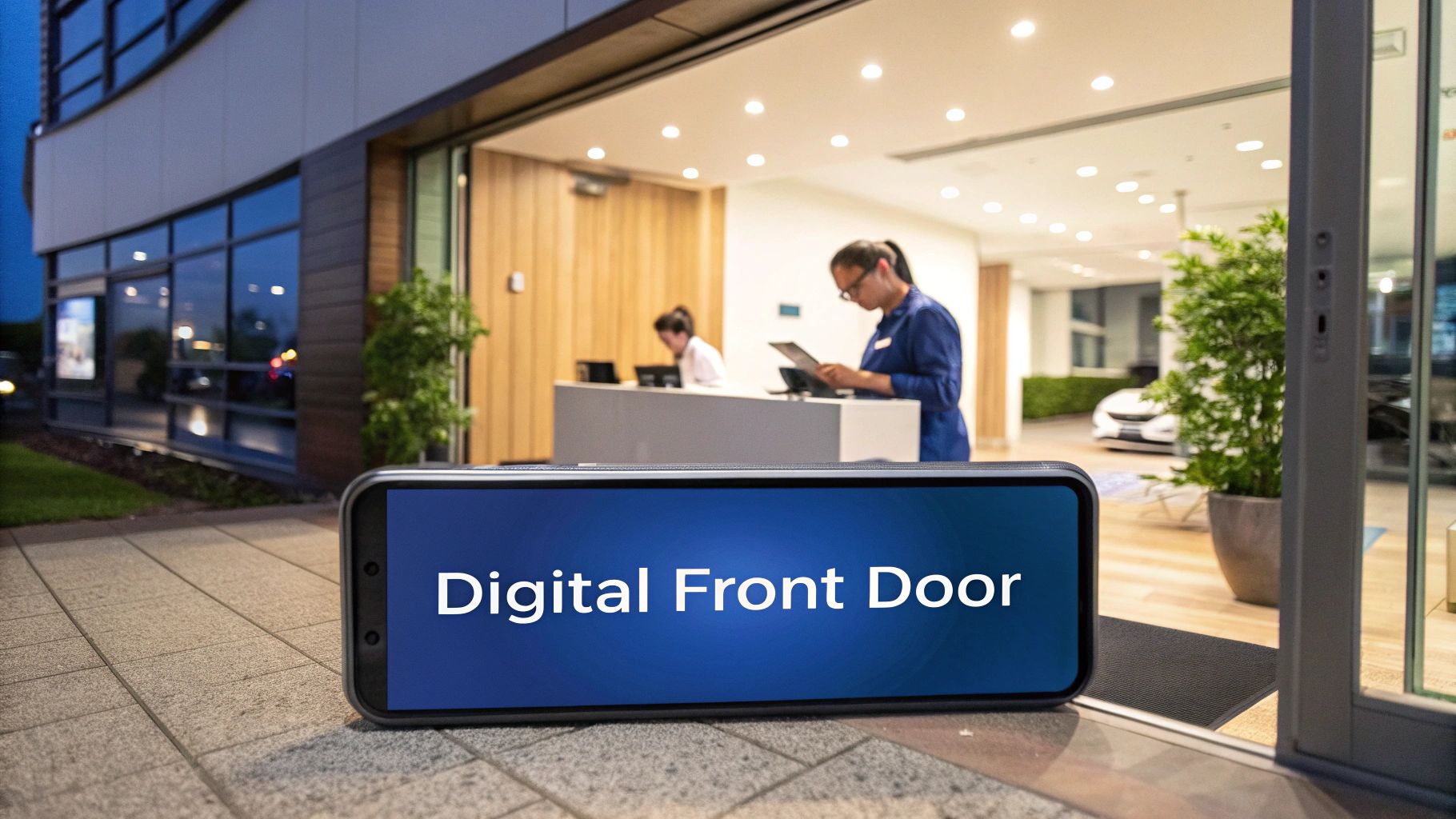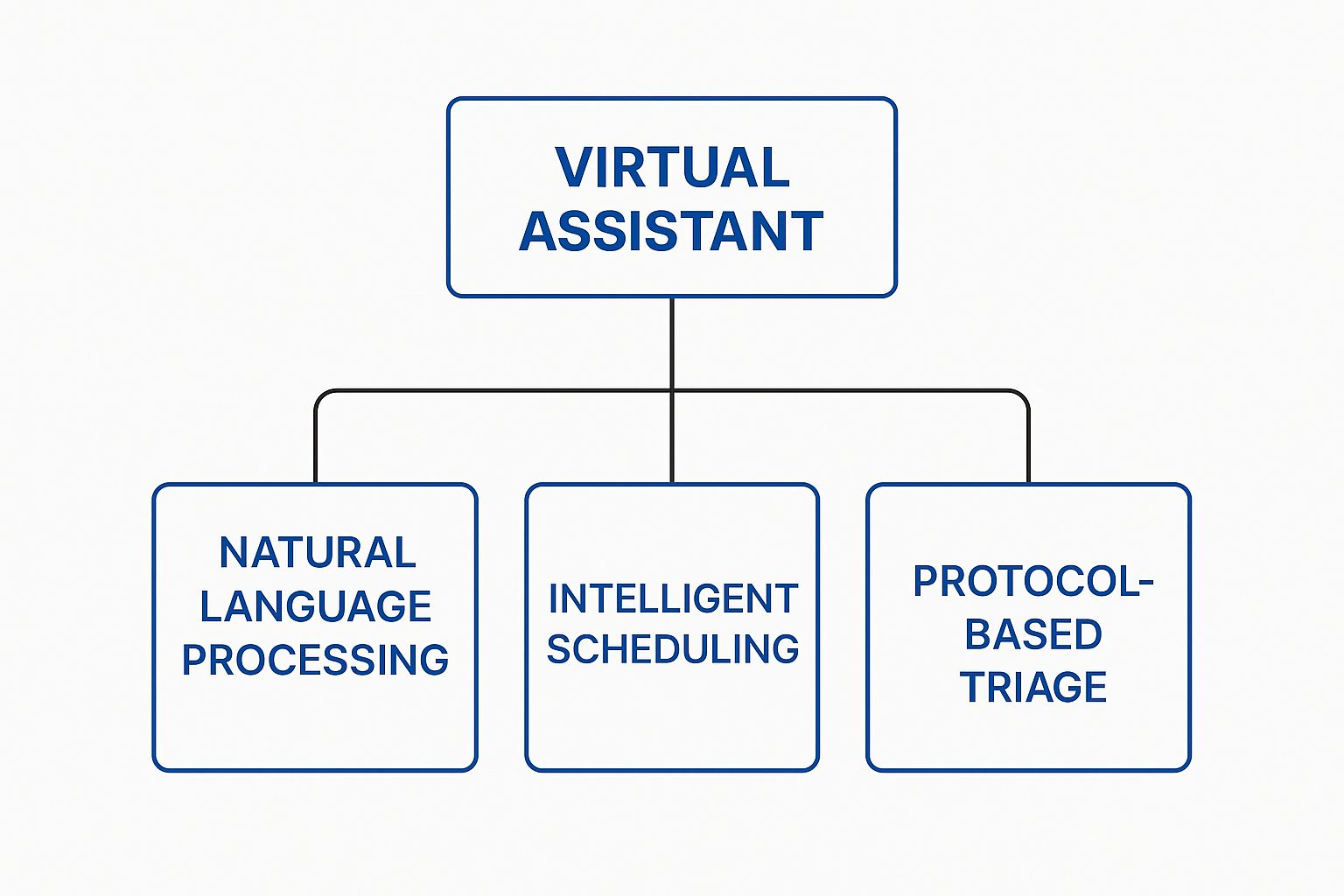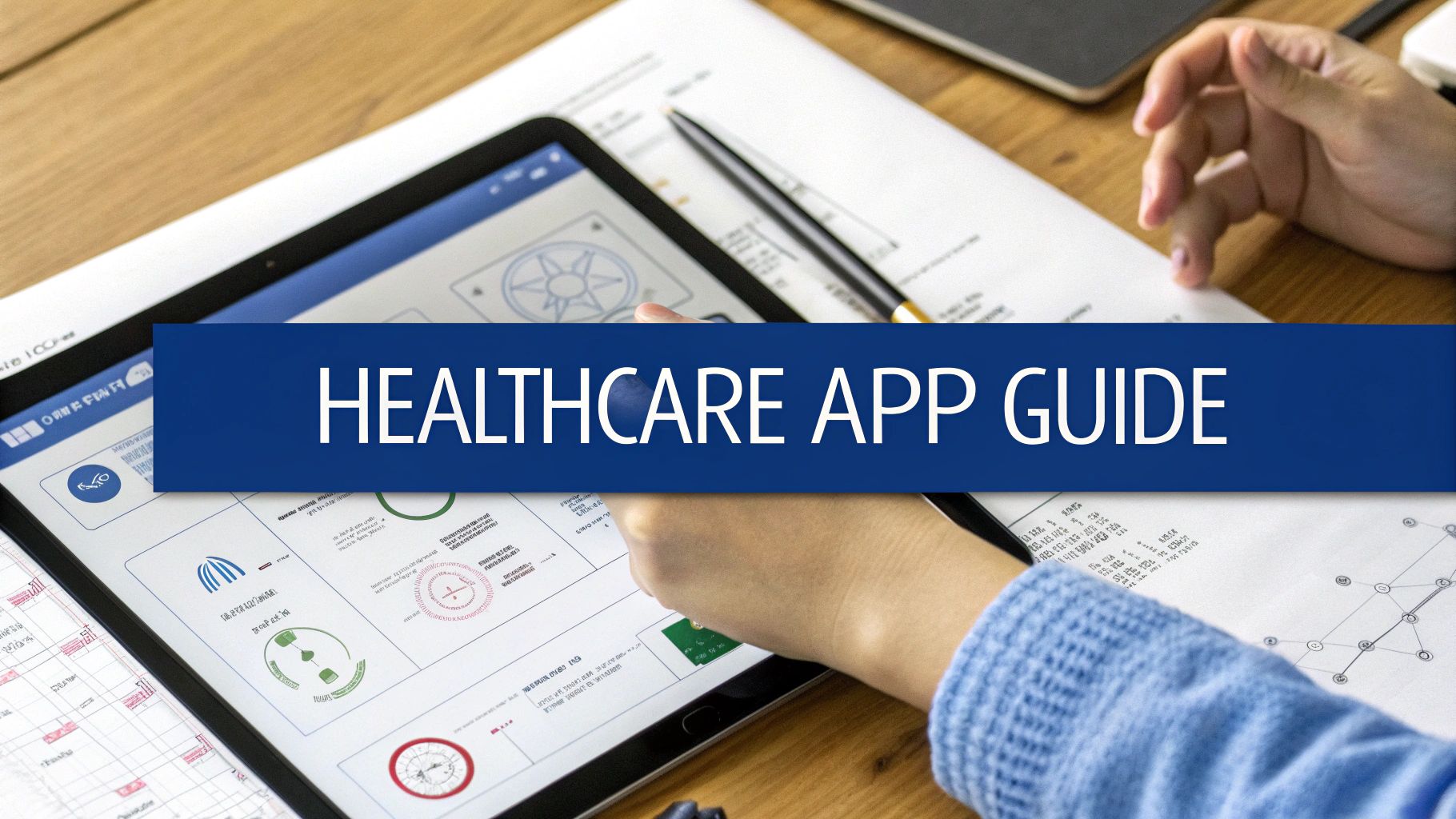A virtual assistant in healthcare is essentially your clinic’s digital front door. It’s a smart AI tool that takes over patient communications and administrative tasks, running 24/7 in the background. Think about a patient who needs to book an appointment at 2 AM or someone who needs a quick medication reminder. The virtual assistant handles it all without anyone on your team needing to lift a finger.
This kind of technology really changes the game for how a clinic operates. By automating all that routine work, your staff can finally step away from the phones and focus on what they do best: direct patient care.
Your Clinic's New Digital Front Door

We all know the traditional patient experience can be a bit of a nightmare. Patients get stuck in long phone queues, get confused trying to book an appointment, and are limited by your 9-to-5 office hours. This old way of doing things isn't just frustrating for them; it puts a massive administrative weight on your staff.
A virtual assistant in healthcare completely overhauls that first point of contact. It creates an entry point that’s smooth, always available, and incredibly efficient. It's much more than a simple chatbot; it's more like an intelligent, automated office administrator that’s been trained to handle the specific needs of a medical practice. This AI tool is built to take on a whole host of tasks that used to eat up your team’s day, providing instant support whenever patients need it.
From Administrative Burden to Automated Efficiency
The main job of this digital front door is to lighten the load for your team. Instead of fielding the same calls over and over about clinic hours or where to park, the virtual assistant gives patients those answers immediately. That single change can have a huge effect on your clinic's workflow and your staff's morale.
Here are a few of the key jobs a virtual assistant can take off your plate:
-
24/7 Appointment Scheduling: Patients can book, change, or cancel their appointments on their own time, from any device. No more waiting for a receptionist to be free.
-
Instant Patient Queries: It can answer all the common questions about your services, insurance policies, and clinic logistics. This keeps your phone lines open for more urgent patient issues.
-
Automated Reminders: It sends out timely reminders for appointments and medications, which is a proven way to cut down on no-show rates, a major headache for many Canadian clinics.
By automating these front-desk tasks, clinics can put their most important resource, their people, back where they belong: delivering high-quality, hands-on patient care and handling more complex clinical work.
This isn't just a futuristic idea anymore; it's becoming a standard part of modern healthcare in Canada and around the world. It gives patients more control and makes their healthcare journey easier, while at the same time creating a more focused and productive work environment for your staff. For any clinic looking to modernize, exploring digital check-in systems for healthcare facilities is a great way to understand what it takes to build this new digital front door. It’s a practical step toward creating a more resilient, patient-centred practice.
How AI Assistants Work in a Clinical Setting
To get a real sense of how a virtual assistant in healthcare works, picture a hyper-efficient medical office administrator who never takes a break. It's an intelligent system built to understand, learn, and act on requests from both patients and staff, completely reshaping the day-to-day workflow in a modern clinic. This isn't just about pre-programmed scripts; it's a sophisticated AI that relies on several key technologies working together seamlessly.
At the core of it all is Natural Language Processing (NLP). This is the magic that lets the AI understand how we actually speak and write. When a patient types, "I need to book a check-up for next Tuesday afternoon," NLP gets to work. It deconstructs the sentence to figure out the intent (booking an appointment), the entity (a check-up), and the specifics (next Tuesday afternoon). This allows for a natural, back-and-forth conversation, freeing people from clunky, rigid menus.
From that point, machine learning algorithms take over. Every single interaction, every question answered, every appointment scheduled, becomes another piece of data for the system to learn from. The assistant gets smarter with thousands of these conversations, constantly refining its responses to become quicker, more accurate, and genuinely more helpful over time.
The Brains Behind the Operation
A virtual assistant is much more than a chatbot; it’s an integrated system that can securely access data to handle some pretty complex tasks. It usually starts with the basics and then builds up to more advanced clinical support duties.
This progression shows how a virtual assistant in healthcare is built on a foundation of core AI technologies to deliver increasingly sophisticated services.

As you can see, strong language skills are the base that allows for intelligent scheduling, which in turn supports more complex tasks like clinical triage.
From Simple Bots to Advanced Clinical Partners
The evolution of a virtual assistant inside a clinic follows a very clear path, with each stage adding another layer of capability and value. The journey almost always unfolds like this:
-
Level 1: Foundational Automation: At the very beginning, the assistant handles the simple, repetitive stuff. It can answer frequently asked questions about clinic hours, directions, or which insurance plans are accepted, which frees up your front-desk staff from answering the same calls all day.
-
Level 2: Interactive Scheduling: Next, the AI connects directly with the clinic’s scheduling software. Now it can see real-time availability, book appointments based on the doctor's schedule and the type of visit, and automatically send out confirmations and reminders.
-
Level 3: Clinical Protocol Integration: This is where things get really advanced. The assistant can now manage tasks that have clinical weight. It can process prescription refill requests by checking a patient's records for eligibility. It can even help triage symptoms by asking a series of questions based on established medical protocols. For example, if a patient mentions chest pain, the AI is programmed to immediately escalate the chat to a human nurse or advise calling emergency services.
The goal is not to replace clinical judgment but to augment it. By handling the initial data gathering and routine tasks, the virtual assistant ensures that when a human provider steps in, they have the necessary information to act quickly and effectively.
This jump in technological capability is attracting serious investment. The Canadian healthcare virtual assistant market was valued at about USD 1.7 billion in 2025, and it’s expected to explode to USD 19.5 billion by 2035. This incredible growth is a direct result of the wider adoption of telemedicine and the growing demand for more efficient, patient-centred care. We're seeing this play out with new platforms offering virtual mental health support and even zero-cost virtual care services expanding across Canada. You can discover more insights about the healthcare virtual assistants market and its rapid growth in the country.
Boosting Efficiency and Patient Satisfaction

Bringing a virtual assistant in healthcare into practice is a smart move that benefits everyone. It creates a powerful win-win, making things smoother for your staff while giving patients a much better experience. These are real, tangible changes you can see in your daily clinic life.
For patients, the difference is felt almost immediately, mostly through sheer convenience. Health concerns don’t stick to a 9-to-5 schedule, so why should access to care? A virtual assistant offers 24/7 availability, letting people book appointments, find answers to common questions, or get information whenever they need it, day or night.
This means no more frustrating hold music or scrambling to call during a lunch break. The system can also send out automated reminders for appointments, a simple feature that has a huge impact on reducing no-show rates. It’s a small touch that helps patients stick to their care plans and feel more connected to your practice.
Transforming the Provider Experience
On your side of the desk, the impact is just as significant. A virtual assistant is all about cutting down the administrative grind and freeing up your clinical team. Let's be honest: in many Canadian clinics, highly skilled professionals are spending way too much time on repetitive, non-medical paperwork.
Think of a virtual assistant as a force multiplier for your staff. It takes over routine jobs like patient intake, appointment scheduling, and answering the same questions about insurance or clinic hours over and over again. By handling these tasks, it directly tackles one of the biggest sources of burnout in the healthcare field.
This newfound time lets your nurses, medical assistants, and doctors get back to what they do best: providing thoughtful, high-quality patient care. If your goal is to make your clinic run more smoothly, this practical guide to automating customer service is a great resource for building a more responsive system.
The real magic happens when you automate the administrative noise. It frees up your team to handle the complex, human-to-human interactions that technology simply can't replace. This leads to better job satisfaction and a healthier work environment for everyone.
To see how this plays out for both patients and providers, let’s break down the key benefits.
Impact of Virtual Assistants on Healthcare Stakeholders
The table below offers a clear comparison of the key benefits for both patients and healthcare providers when a virtual assistant is introduced.
|
Area of Impact |
Benefit for Patients |
Benefit for Healthcare Providers |
|---|---|---|
|
Accessibility |
24/7 access to book appointments and get answers without waiting for office hours. |
Reduced call volume and fewer interruptions for front-desk staff. |
|
Scheduling |
Self-service booking, rescheduling, and cancellations for maximum convenience. |
Drastically lower no-show rates due to automated reminders, leading to better revenue capture. |
|
Communication |
Instant responses to frequently asked questions about services, hours, or preparation. |
Less time spent by staff on repetitive queries, freeing them for complex patient needs. |
|
Engagement |
Proactive reminders for appointments and follow-ups, improving care plan adherence. |
Enhanced ability to manage large patient populations with consistent, automated outreach. |
|
Overall Experience |
A feeling of empowerment and control over their healthcare journey with user-friendly tools. |
Lower administrative costs, reduced staff burnout, and more time for direct patient care. |
As you can see, the improvements are felt across the board, creating a more efficient and positive healthcare environment.
A Symbiotic Relationship
Ultimately, the benefits for patients and providers are two sides of the same coin. When patients feel empowered and can easily find information, they show up to their appointments more prepared and less anxious. That makes for a much smoother and more positive visit for your clinical staff.
On the flip side, when your team isn't buried under administrative tasks, they have the mental and emotional energy to provide truly attentive, compassionate care. That improved care builds patient satisfaction and trust. This is where solid https://www.cleffex.com/blog/patient-data-management-with-ai/ becomes so important, as it’s the backbone that ensures information flows securely and efficiently.
A virtual assistant in healthcare isn't just a tool for one group or the other. It’s a piece of foundational technology that strengthens the entire relationship between a patient and their provider, leading to better health outcomes for everyone.
Real-World Applications in Canadian Healthcare

The theory behind a virtual assistant in healthcare is one thing, but seeing it work in the real world is where its value truly shines. These AI tools aren't just futuristic concepts; they are actively solving day-to-day problems in busy Canadian hospitals, rural clinics, and local pharmacies. From coast to coast, they’re making a real difference for patients and the people who care for them.
The widespread shift to virtual care, spurred on by necessity, really set the stage for this. In the thick of the recent pandemic, about 60% of Canadians used virtual channels to connect with healthcare providers. The change was especially dramatic in Ontario, where the number of primary care doctors offering virtual services shot up from just 7.0% in 2019 to an incredible 85.9% in 2020. This period proved that both patients and providers were ready to embrace digital health, paving the way for more sophisticated tools like AI assistants. You can read the full research about this pivotal shift in Canadian healthcare delivery.
Streamlining Urban Hospital Operations
In major cities like Toronto or Vancouver, patient volume is a relentless pressure. Imagine a large urban hospital grappling with a high rate of missed appointments and phone lines that are constantly jammed. By bringing in a smart virtual assistant in healthcare, the hospital can put its entire scheduling and reminder system on autopilot.
The AI assistant can now handle bookings, send out personalized reminders by text or email, and let patients confirm or reschedule their appointments with a quick reply. The payoff is huge:
-
A 30% drop in patient no-shows, which boosts clinic efficiency and protects revenue.
-
Much shorter wait times on the phone, since the AI handles all the routine scheduling traffic.
-
Happier patients who appreciate the convenience of managing their appointments anytime, day or night.
This is a perfect example of how a virtual assistant can clear administrative logjams in a high-stakes environment, freeing up staff to focus on more hands-on patient care. For a deeper dive, check out these powerful AI solutions for hospitals in Canada.
Enhancing Chronic Disease Management in Rural Areas
For rural and remote communities, the challenge is distance. A clinic in a remote part of British Columbia, for instance, needed a better way to support patients with chronic conditions like diabetes without making them travel for hours. Their solution was a virtual assistant built for remote patient monitoring.
Now, the system automatically sends daily or weekly check-in questions to patients' phones, asking about their symptoms or blood sugar levels. If a patient’s answer flags a potential problem, the system instantly alerts a nurse to follow up.
This proactive approach completely changes the dynamic of chronic care, moving it from reactive to preventative. Patients are empowered to manage their health from their own homes, while clinicians get the timely data they need to step in before a small issue becomes a big one.
Broadening Access to Mental Health Support
The demand for mental health services across Canada is surging, often overwhelming the number of available professionals. Here, virtual assistants are stepping in to offer that critical first layer of support and help people find the right resources.
These AI tools offer a safe, anonymous starting point for anyone seeking help. They can guide users through initial self-assessments, point them toward credible mental health resources, and even teach basic coping techniques. While they’ll never replace a human therapist, this kind of virtual assistant in healthcare acts as an effective "bridge to care," helping people get the right support, faster.
Modernising Local Pharmacy Services
Pharmacies are another place where virtual assistants are making a huge impact. They're being used to manage prescription refills and answer common medication questions, which frees up pharmacists to have more important clinical conversations with patients.
With an AI assistant, patients can:
-
Request prescription refills automatically.
-
Get reminders when it’s time to take their medication.
-
Ask common questions about side effects or dosages.
This simple automation cuts down on wait times at the pharmacy counter and reduces the risk of medication errors, creating a safer, smoother experience for everyone involved. As these real-world examples show, the virtual assistant is an incredibly versatile and powerful tool for bringing Canadian healthcare into the future.
Making a New Virtual Assistant Work for You
Bringing any new technology into a clinical setting has its hurdles, and a virtual assistant in healthcare is no exception. It’s not just about picking the right software. True success comes from a solid plan that accounts for everything from the technical setup and data security to the people who will actually use it every day.
A well-thought-out implementation process makes sure the new tool is a genuine help to your staff and patients, not just another source of frustration. By tackling the biggest concerns head-on, you can make the rollout a smooth and positive experience for everyone.
Getting Data Privacy and Compliance Right
In healthcare, protecting patient information is always priority number one. Here in Canada, that means strict compliance with laws like the federal Personal Information Protection and Electronic Documents Act (PIPEDA) and provincial rules like Ontario's Personal Health Information Protection Act (PHIPA). These aren't just suggestions; they're firm legal requirements for handling personal health data.
Any virtual assistant you consider must be built with rock-solid security from the ground up. This means looking for a few key features:
-
End-to-end encryption for every single interaction.
-
Secure data storage on servers physically located within Canada.
-
Strict access controls to ensure only authorised staff can see sensitive information.
Falling short on compliance can lead to hefty fines and, worse, a devastating loss of patient trust. Partnering with a vendor who has deep experience in Canadian healthcare compliance is essential.
To get a better handle on this critical area, our guide on AI in healthcare and Canadian data privacy is a great place to start. It’s crucial to get this piece of the puzzle right from day one.
Making Sure All Your Systems Talk to Each Other
Another major consideration is how well the new virtual assistant will play with the systems you already use, especially your Electronic Health Record (EHR) or Electronic Medical Record (EMR). A tool that operates in a silo just creates more work, defeating the whole purpose. The dream is a connected system where an appointment booked via the assistant instantly shows up in the clinic’s main schedule, no manual data entry required.
This is where the deployment model really matters. In 2023, most of the Canadian market was dominated by cloud-based and standalone virtual assistants. Cloud solutions are often preferred for their ability to grow with a clinic and their lower upfront costs. On the other hand, standalone platforms are popular because they can be easier to get up and running, often working independently of complex EHRs. Despite some challenges like high initial costs and tricky integrations, their use is on the rise, largely because of the growing need for remote patient monitoring. You can dig into these trends in the Canadian healthcare virtual assistants market findings.
Helping Your Team Embrace the Change
At the end of the day, technology is only effective if people actually use it. It's completely normal for staff to be a bit hesitant about new workflows or feel a little intimidated by AI. Addressing these concerns head-on is key to a successful launch.
A proactive approach focused on training and open communication can make all the difference in building confidence and getting your team on board.
-
Start with a Pilot Program: Kick things off with a small-scale rollout in a single department. This lets you iron out any kinks before you go live across the entire clinic.
-
Offer Real-World Training: Run hands-on training sessions that show your team exactly how the virtual assistant in healthcare will make their jobs easier, not more complicated.
-
Get Patients Involved: Let your patients know about the new tool. Explain how it benefits them with things like 24/7 access and more convenience; they'll be much more likely to use it if they know what’s in it for them.
The Future of AI-Powered Patient Care
What we're seeing now with the virtual assistant in healthcare is really just the opening act. The tools we have today are laying the foundation for something far more connected and intelligent, where AI becomes a genuine partner in delivering personalised care. The next wave of this technology is going to push way beyond simple appointment scheduling and reminders.
The most exciting trends point to AI assistants becoming deeply woven into the fabric of clinical decision-making. We're on the verge of assistants that can provide sophisticated diagnostic support, cross-referencing a patient's live data against enormous medical databases in a split second. This isn't about replacing a doctor's intuition, but supercharging it with incredible data-crunching power.
A More Connected and Proactive System
The real game-changer is linking the virtual assistant to the ever-growing world of personal health tech. Think about an AI that pulls data directly from a patient's smartwatch, fitness tracker, or continuous glucose monitor.
That kind of direct connection opens the door to truly proactive healthcare. Instead of waiting for a patient to feel sick and report symptoms, the system can spot subtle warning signs in their health data and flag them for follow-up.
-
Real-Time Health Monitoring: Imagine an assistant that notices an irregular heartbeat from a wearable device and immediately alerts both the patient and their clinician.
-
Proactive Interventions: Based on that data, it could suggest booking a telehealth appointment or offer immediate guidance, potentially stopping a serious health issue in its tracks.
We're talking about a fundamental shift from a reactive to a predictive model of care. By constantly monitoring a person's unique health data, a virtual assistant can help catch problems early and become a true partner in their long-term wellness.
Augmenting Human Expertise, Not Replacing It
It’s so important to be clear about one thing: this future isn't about technology taking over from healthcare professionals. The whole point is to augment human skills, not make them redundant. By offloading the heavy lifting of data analysis and routine monitoring, these advanced systems will free up doctors, nurses, and clinicians.
This gives them back precious time to focus on the parts of medicine that are uniquely human, complex diagnoses, empathetic conversations, and building the trusting relationships that are at the heart of good care. The future is collaborative. The virtual assistant in healthcare crunches the numbers, so the professional can focus on the person. The result? A more connected, efficient, and truly patient-first Canadian healthcare system.
Got Questions? We've Got Answers
Bringing any new technology into your practice is a big step, and it's natural to have questions. Let's walk through some of the most common ones we hear about using a virtual assistant in healthcare, so you can get a clearer picture of what it can, and can’t, do for your team and your patients.
What Exactly is a Health AI Assistant?
Think of an AI health assistant as a smart, automated front-line support tool. It’s a piece of software that uses conversational AI to chat with patients and staff naturally. Its job is to answer questions, guide people through symptom checks based on established protocols, and point them towards the right care, whether that's booking an appointment or seeking emergency help. The best part? It's always on, providing instant support day or night.
Will a Virtual Assistant Replace My Staff?
Not at all. The goal here is collaboration, not replacement. A virtual assistant in healthcare is designed to take over the high-volume, repetitive tasks that tie up your skilled professionals' time. This means your doctors, nurses, and admin staff can step away from routine scheduling and basic queries to focus on what they do best: complex patient care, critical decision-making, and providing the kind of human empathy that technology can't replicate.
It's really about making your team more efficient. By fielding the simple stuff, the assistant frees up your people to operate at the top of their licence, leading to better, more hands-on care for your patients.
What Kinds of Tasks Can it Actually Do?
A medical virtual assistant is surprisingly versatile. It excels at managing specific, defined workflows that are predictable but time-consuming.
Here’s a quick rundown of its core duties:
-
Handling Appointments: It can schedule, reschedule, and cancel appointments for patients 24/7, without anyone needing to pick up the phone.
-
Initial Symptom Triage: It guides patients through a series of questions (based on your clinic's protocols) to help gauge urgency and direct them to the right next step.
-
Automated Patient Outreach: It can send out appointment confirmations, medication reminders, and pre-visit instructions automatically.
-
Answering Common Questions: It acts as an instant information source for things like clinic hours, location, services offered, or which insurance plans you accept.
-
Telehealth and Remote Aid: It can help patients get set up for a virtual visit or even collect basic data from connected devices like smartwatches.
Its real power lies in automating the administrative and communication grind. This brings consistency and round-the-clock availability to your practice, which lightens the load on your staff and creates a much smoother, more organized experience for patients.
How Secure is it with Patient Information?
This is the most important question, and the answer is: it has to be incredibly secure. Security is the absolute baseline for any virtual assistant in healthcare. When you're choosing a solution, look for providers who are purpose-built for the Canadian healthcare environment and are fully compliant with privacy laws like PHIPA.
This means you should expect multiple layers of security. We’re talking about end-to-end data encryption, secure data centres located on Canadian soil, and tight access controls to ensure only authorized personnel can view sensitive information. Always do your homework and make sure any vendor can prove their compliance and show you their track record in healthcare. Building and maintaining patient trust depends on it.
At Cleffex Digital Ltd, we build secure, compliant, and intelligent software solutions that help healthcare practices thrive. Our expertise in AI and custom development can help you integrate a virtual assistant that meets your unique clinical needs. Learn how Cleffex can modernise your patient engagement.








